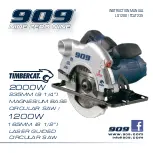
English
10
Fig. F
8
16
Fig. G
LOOSEN
(counterclockwise)
7
14
11
TIGHTEN
(clockwise)
6
To Replace the Blade (Fig. F, G)
1. To loosen the blade clamping screw
8
, depress the
blade lock button
11
and turn the saw spindle with the
blade wrench
14
until the blade lock engages and the
blade stops rotating. With the blade lock engaged, turn
the blade clamping screw counterclockwise with the
blade wrench (screw has right-hand threads and must
be turned counterclockwise to loosen).
2. Remove the blade clamping screw
8
and outer clamp
washer
16
only. Remove old blade.
3. Clean any sawdust that may have accumulated in the
guard or clamp washer area and check the condition
and operation of the lower blade guard as previously
outlined. Do not lubricate this area.
4. Select the proper blade for the application (see
Blades
). Always use blades that are the correct size
(diameter) with the proper size and shape center hole
for mounting on the saw spindle. Always assure that the
maximum recommended speed (rpm) on the saw blade
meets or exceeds the speed (rpm) of the saw.
5. Follow steps 2 through 5 under
To Install the Blade
,
making sure that the blade will rotate in the proper
direction.
Lower Blade Guard
WARNING: The lower blade guard is a safety
feature which reduces the risk of serious
personal injury. Never use the saw if the lower
blade guard is missing, damaged, misassembled
or not working properly. Do not rely on the
lower blade guard to protect you under all
circumstances. Your safety depends on following
all warnings and precautions as well as proper
operation of the saw. Check lower blade guard
for proper closing before each use as outlined
in
Further safety instructions for All saws
.
If the lower blade guard is missing or not
working properly, have the saw serviced before
using. To assure product safety and reliability,
repair, maintenance and adjustment should
be performed by an authorized service center
or other qualified service organization, always
using identical replacement parts.
Blades
WARNING:
To minimize the risk of eye injury, always
use eye protection. Carbide is a hard but brittle
material. Foreign objects in the workpiece such as wire
or nails can cause tips to crack or break. Only operate
saw when proper saw blade guard is in place. Mount
blade securely in proper rotation before using, and
always use a clean, sharp blade.
WARNING:
Do not cut metal, plastic, concrete,
masonry or fiber cement materials with this saw.
Do not use abrasive wheels or blades. A dull blade will
cause slow inefficient cutting, overload on the saw motor,
excessive splintering, and could increase the possibility of
kickback. Please refer to the table below to determine the
correct size replacement blade for your model saw.
RECOMMEnDED BlADE TYPEs
Combination Framing
5/8" Round arbor, 24 teeth
All purpose fast rip and cross
cuts.
Pressure Treated/Wet
Lumber
5/8" Round arbor, 20 teeth
Coated, resistant to gum
build-up
Extreme Durability
5/8" Round arbor, 18 teeth
Coated, rock carbide
Finishing
5/8" Round arbor, 36 teeth
More teeth for finer finish cuts.
Fast Cut Framing
5/8" round arbor, 18 teeth
Fastest blade for rips and cross
cuts
If you need assistance regarding blades, please call
1–800–4-DeWALT (1–800–433–9258).
Kickback
Kickback is a sudden reaction to a pinched, bound or
misaligned saw blade, causing an uncontrolled saw to lift
up and out of the workpiece toward the operator. When
the blade is pinched or bound tightly by the kerf closing













































